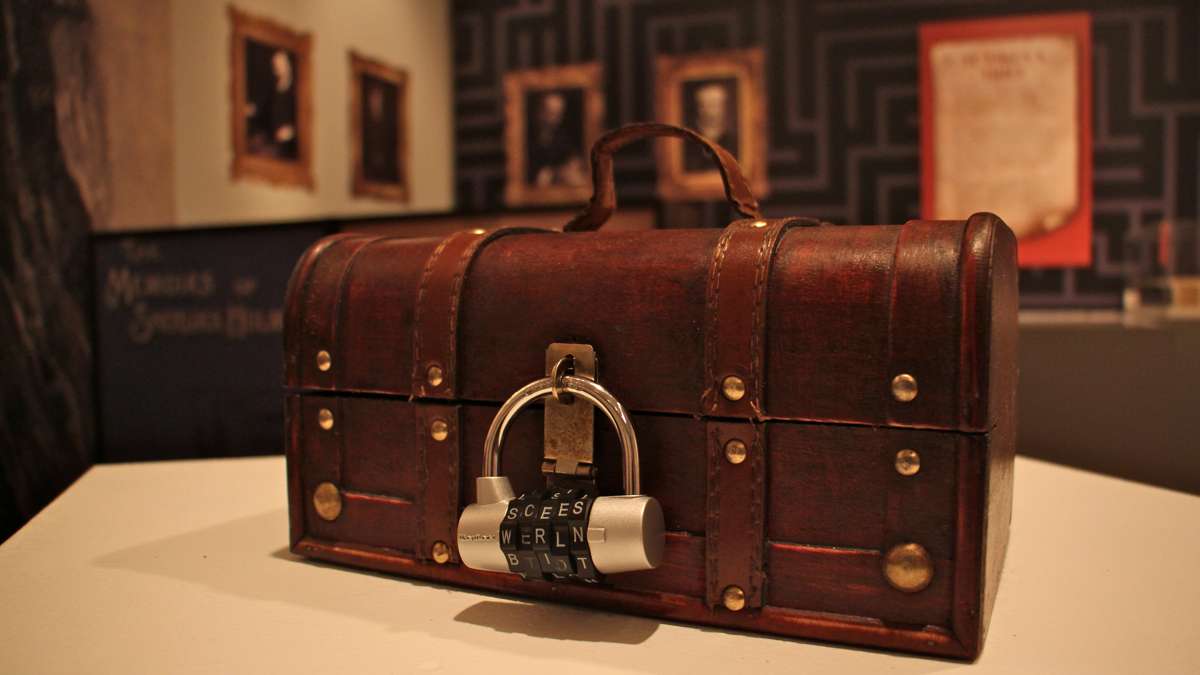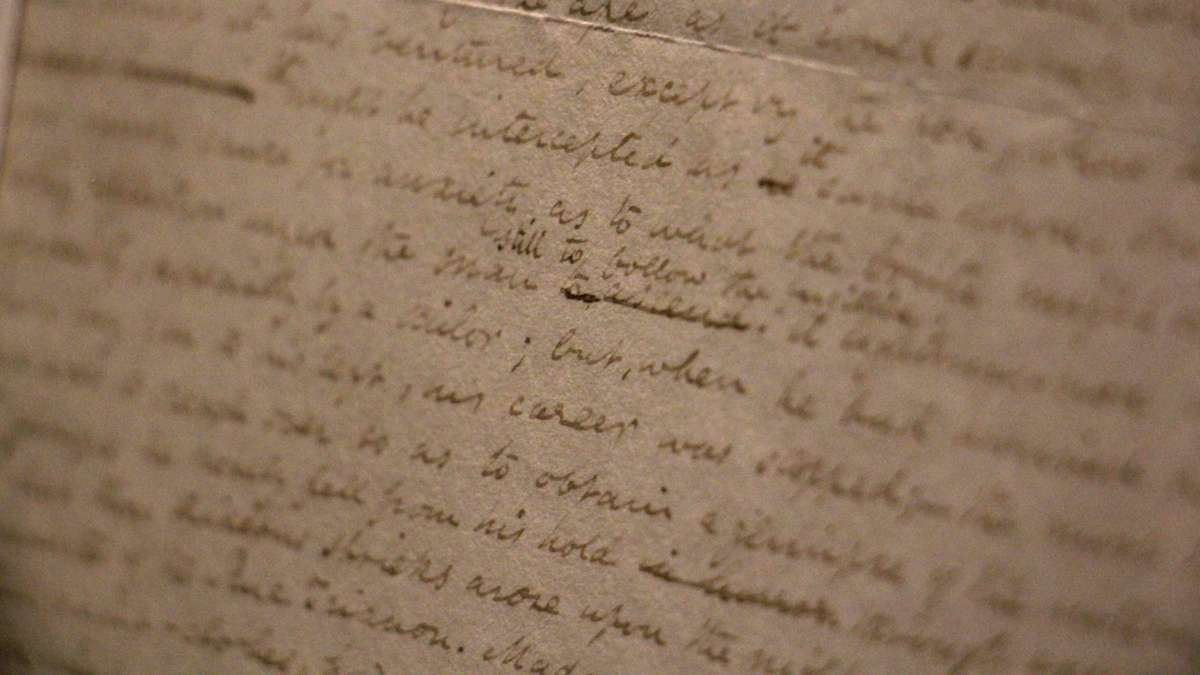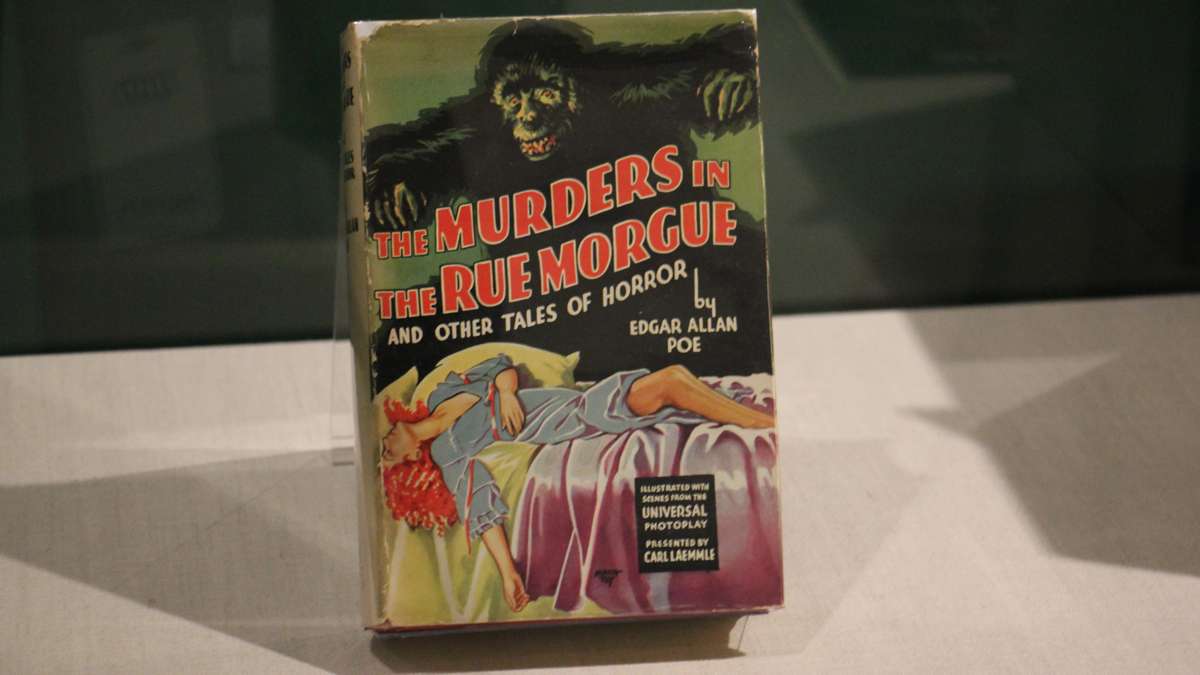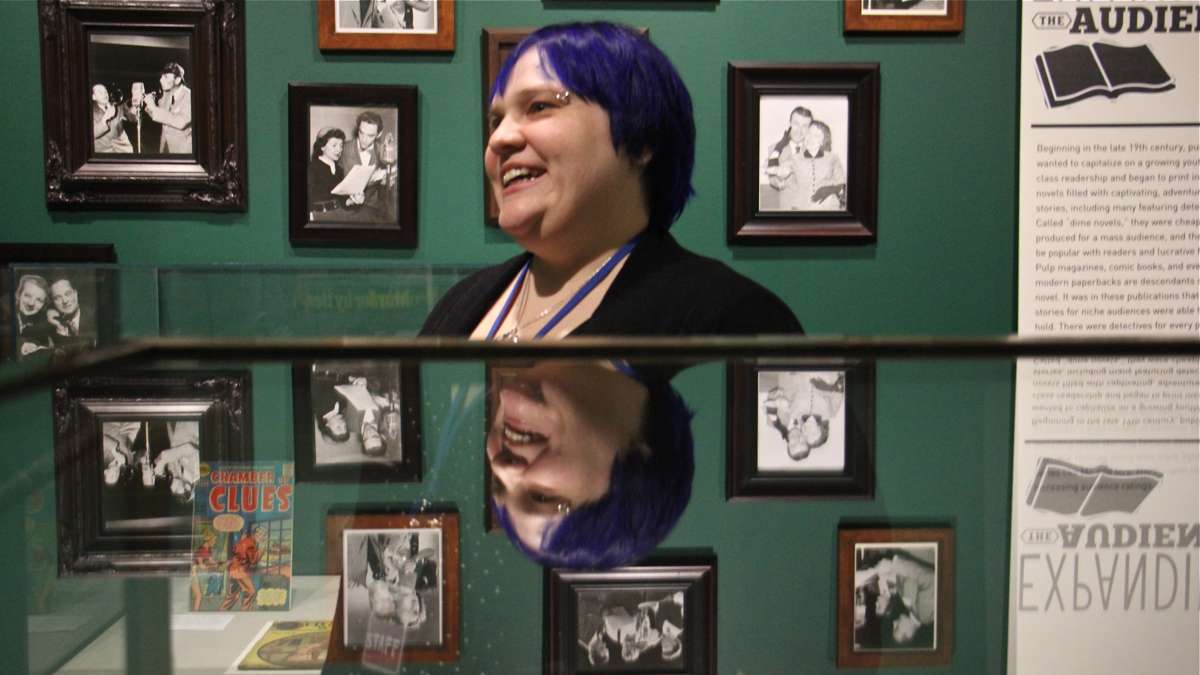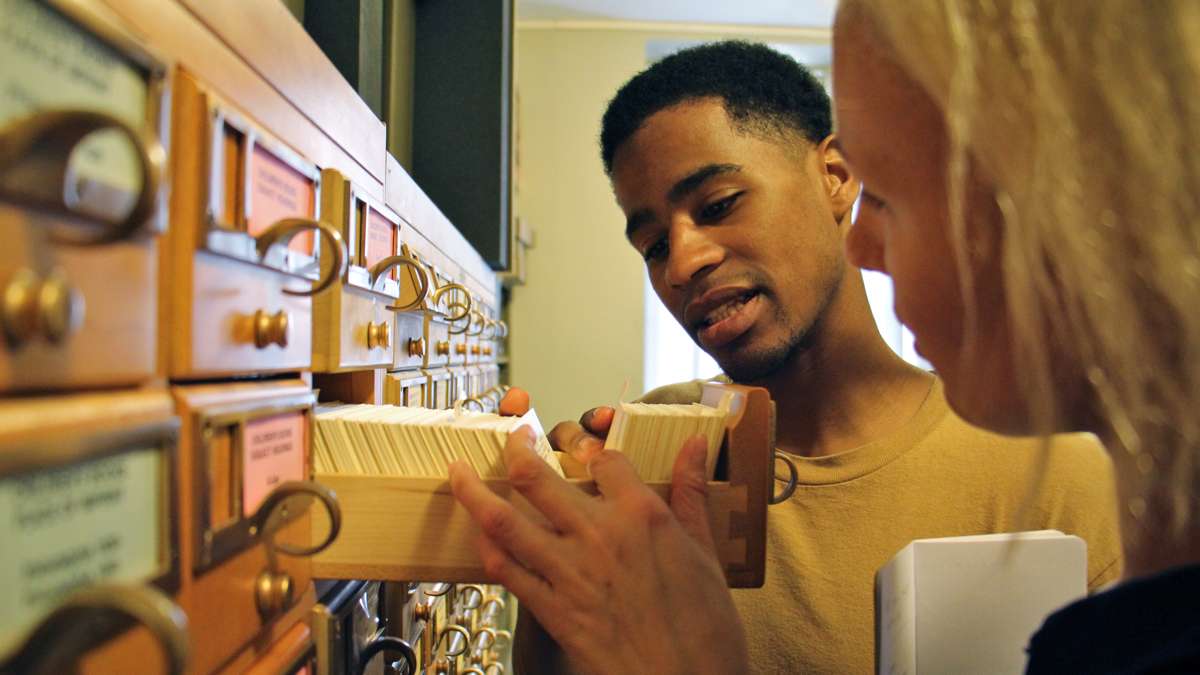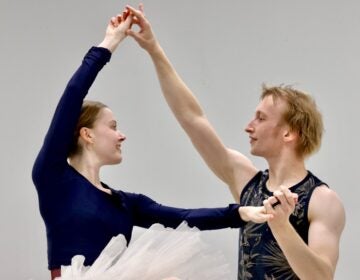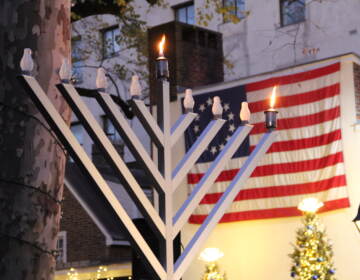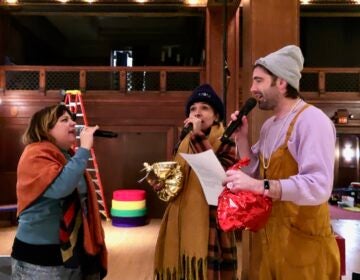Philadelphia’s Free Library stages an ambitious detective mystery game [photos]
ListenIn the lobby of the Free Library on the Parkway in Philadelphia, I joined a group of three people I’ve never met before. We’re given small, red notebooks with the letter G printed on the covers.
A security guard approaches us. He palms a note to one in the group, telling us not to look at it until he leaves the room.
He leaves. The note is a drawing of elevator signage. We go to the elevator, where we are met by a young, chipper woman wearing a badge. She says she’s from “the bureau.” I don’t know what the bureau is.
“Welcome to Gumshoe training,” she says, ushering us into the elevator car. “What do you already know about detection?” I don’t know what she’s getting at. We just got here.
“There are two parts to Gumshoe training. Part one: building your skills in connections, dichotomies and serendipities,” she says, talking too fast for me to follow. “Make liberal use of your notebooks, write down anything that strikes you, your curiosities, your questions, what makes sense, what doesn’t make sense.”
So far, plenty doesn’t make sense. I don’t know why we’ve been led to the Rare Book Department on the third floor, and I’m not sure what I should be looking for. A shadowy figure comes into the room, wearing dark glasses and a trench coat.
“Excuse me, sir? Can I ask you what you’re doing?” I ask, using a vaguely accusatory tone. “I’m just looking at some of the rare materials,” he says, with the shifty mumble of a liar. Then he scampers off down the hallway, a rabbit down a hole, beckoning us to follow. I wonder if he’s an agent with the mysterious bureau, or some kind of counter-agent operating in opposition to the bureau, or just some creepy guy in the public library.
I asked the director for some clarification. “I wouldn’t want to either confirm or deny what you’re saying,” said Whit MacLaughlin, the architect of this performance, called Gumshoe, in an interview. “It’s the frame of mind that engendered in you, that is our goal.”
MacLaughlin is the artistic director of New Paradise Laboratories, a longstanding Philadelphia experimental theater company. He was commissioned by the Free Library to create this walking theatrical experience wherein audience members go on a sleuthing hunt through the library, exploring rooms in the building that are otherwise off limits to patrons.
“This building is like a ‘Clue’ game,” he said. “There’s a conservatory, the library, and secret passageways that go from one to the other. The building is literally like a rabbit warren.”
This performance is happening here because this library houses the manuscript for Edgar Allan Poe’s short story, “The Murders in the Rue Morgue,” often regarded as the first detective story. It’s now on display as part of “Becoming the Detective,” an exhibition about the evolution of the mystery fiction.
Poe may have invented the prototypical fictional detective — C. Auguste Dupin — but he did not write a story with a trail of clues that the reader could follow to solve the crime along with Dupin. That wasn’t the aim of his story. It took decades for the rules of the genre — that social contract between an author’s invention and readers’ expectations — to solidify.
In the 1920, the Catholic priest and crime novelist Ronald Knox, and the art critic Williard Wright (aka S.S. Van Dine), working separately, each compiled a list of rules for crime writers to work by.
“So that the reader had a fair chance of being able to solve the mystery at the heart of the book,” said Karin Suni, a curator in the library’s Rare Book Department. “You couldn’t have the detective be the criminal. You couldn’t suddenly throw twins in the mix. If the author pushed the envelope or broke the rules, there was backlash.”
Detective fiction is one of the most, if not the most popular literary genre of publishing, one that is shaped as much by consumers as authors. Suni traced the evolution of the genre through popular culture, using radio plays, movie posters, television clips, Nancy Drew paperbacks, and even plastic Scooby Doo toys, drawing a line connecting Poe’s Dupin with Benedict Cumberbatch’s “Sherlock” on PBS.
“I really wanted something that highlighted this very popular nature of these genre, and the fact that it goes into stage plays, radio, television, movies,” said Suni. “That we have the original manuscript of Murders in the Rue Morgue here in the rare book department is helpful to kick the whole thing off.”The exhibition was the inspiration for the play, to make the audience members active participants.
The Free Library houses a great number of mysteries and treasures; for example, a secret document kept outside the Rare Book room doors, in a glass case shielded by a gold shroud. It’s something that is now crucial to us learning to become detectives.
“Gather in closely, guys. Thanks,” said Beetle, a.k.a. Gold Bug, another agent with the mysterious bureau leading a small group of Gumshoe audience members.”This is why you guys are here, OK?” said Beetle, played by Jenson Titus Lavalee, inexplicably whispering in an otherwise empty hallway. “This is the mystery we brought you in for. So, um, you guys are the first people we’ve been allowed to share this with.”
Lavalee pulls away the shroud, unveiling a hand-written document, purportedly in the hand of Edgar Allen Poe. It’s a kind of dream map, a drawing that plots out “The Murders in the Rue Morgue.”
It looks a bit like a celestial map. He doesn’t give us much time to look before he covers it up again.
Lavalee explains that this document was only recently discovered under the floorboards of the historic Poe House in Northern Liberties, while the building was undergoing renovations last summer.
As a journalist I’m duty bound to tell you that document, as well as its backstory, is hogwash. But, as an audience member, I’m committed to embracing it as the lynchpin to this investigation.
“So the mystery, the question is: Why would Poe have wanted to hide these under the floorboards?” says Beetle. “We don’t know.”
Beetle immediately disappears. One of my fellow investigators, audience member Charlotte Wells, begins writing in her little red G notebook.
“There are a lot of constellations happening,” observed Wells. “Like, you know the map we saw? It had a constellation on it. And he had a constellation shirt on.”
She’s right. He did wear a shirt with a constellation print. Is she onto something — or is she paranoid?
“Dupin always says, ‘Don’t go too deep. Look broad,'” advised MacLaughlin. “Look to the wide landscape. Look out the corner of your eye. See what your intuition notices. It’s a very intuitional style of detection.”
The answer lies outside. Breaking the unwritten rules of library exhibitions, the denoument is not within the building — it continues at the Free Library’s other site, the Rosenbach Museum and Library in Rittenhouse Square.
That’s where we’re going next.
The Rosenbach has a companion exhibition, “Clever Criminals and Daring Detectives,” a prequel to “Murders in the Rue Morgue.” It begins in the 17th century, when there were no detectives – neither fictional nor real. Crime writing at that time was true crime: bloody stories of street thugs, murders, and executions told in hysterical language.
“A most shocking murder,’ reported in the most grisly way,” said Judy Guston, reading a wall of historic broadsides — one-sheet newspapers for posting on walls. “‘The diabolical deed was perpetrated… It’s very colorful language.”
One of the broadside depicts captured or executed criminals, identifying them with portrait illustrations and colorful names. These perpetrators were not just criminals, they were soon to become literary archetypes.
“Cupid the Barge-Robber. One-Eyed Thompson. Billy Fish, the Dandy Pickpocket. Writers like Charles Dickens, Conan Doyle, and Edgar Allan Poe would mine these rogue’s galleries to find cretins that populated their fiction.
This exhibition suggests that writers would not just invent fictional detectives, they invented real detectives. In the early 18th century people like Daniel Defoe were writing pamphlets advocating for a community-based police force with the ability to investigate crime. Dafoe was describing a detective — something that had never before existed.
“When we see writers suggesting that’s how things should be organized – maybe we should get some people together and have a police force – that’s how things happened,” said Guston. “People who are writing about crime, rather than happening organically out of government.”
In the center of the exhibition is a leather box locked with a combination padlock. Using the fabricated map from the Free Library, and clues gleaned from this room, you should be able to figure out how to open the lock.
“Then you find this,” said Guston, pulling out a folded map of Philadelphia streets overlaid with lines resembling to the constellation Orion. In the middle is a radiating star.
“You find you’re not there yet,” said Guston. “It directs you to do something else.”
Using the clues in that box, which Guston neatly repacks and relocks, the hunt for truth takes you out on the streets of Philadelphia, where the mystery continues.
WHYY is your source for fact-based, in-depth journalism and information. As a nonprofit organization, we rely on financial support from readers like you. Please give today.




